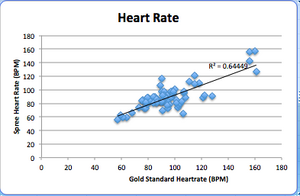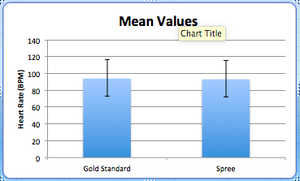BME100 s2015:Group11 12pmL3
| Home People Lab Write-Up 1 | Lab Write-Up 2 | Lab Write-Up 3 Lab Write-Up 4 | Lab Write-Up 5 | Lab Write-Up 6 Course Logistics For Instructors Photos Wiki Editing Help | ||||||
|
OUR TEAM
LAB 3A WRITE-UPDescriptive StatisticsBody Temperature Gold Standard Mean: 97.334°F Spree Mean: 98.713°F Gold Standard Std. Deviation: ± 2.846°F Spree Std. Deviation: ± 0.569°F Heart Rate Gold Standard Mean: 94.0y BPM Spree Mean: 93.17 BPM Gold Standard Std. Deviation: ± 22.57 BPM Spree Std. Deviation: ± 20.99 BPM
Results   
AnalysisInferential Statistics Body Temperature: T-Test Value: 1.12E-8 Pearson R-Value: -0.054 Heart Rate: T-Test Value: 0.326 Pearson R-Value: 0.560
Summary/DiscussionThe results for the comparison between the Spree temperature and the gold standard temperature show that there is no significant difference in these temperatures as the T-Test value is less than 0.1. The reason for this is because the Spree headband does not show the exact temperature, only colors that represent on single temperature, and there are only four colors. This lack of accurate, numerical temperature is a limitation of the Spree headband and could be improved by improving the thermometer aspect.
LAB 3B WRITE-UPTarget Population and NeedOur target population is the "average Joe." The average American spends ten hours per day working and caring for children or others. Only 29% of American adults get the CDC recommended amount of muscle strengthening exercise per week. FEMS technology would help strengthen the muscles of average adults who do not have the time or energy to exercise as much as recommended.
Device DesignThis device has the shell of a morphsuit with "smart skin" technology wired throughout the suit. It delivers precision amounts of electric stimulation to muscle groups throughout the body to contract muscles and stimulate muscle growth. 
Inferential StatisticsOur statistics our taken from theoretical measurements of 50 participants doing the CDC suggested cardiovascular and muscular exercise for 6 months and 50 participants doing the recommended cardiovascular exercise and wearing the FEMS suit for 30 minutes, 3 times per week for 6 months. Participant lean body mass composition is measured every week and progress is recorded. T-test:7.49585E-06 Pearson's R value:0.984846026 The FEMS technology results in slightly higher lean muscle gain than regular exercise.
Graph
|
||||||



